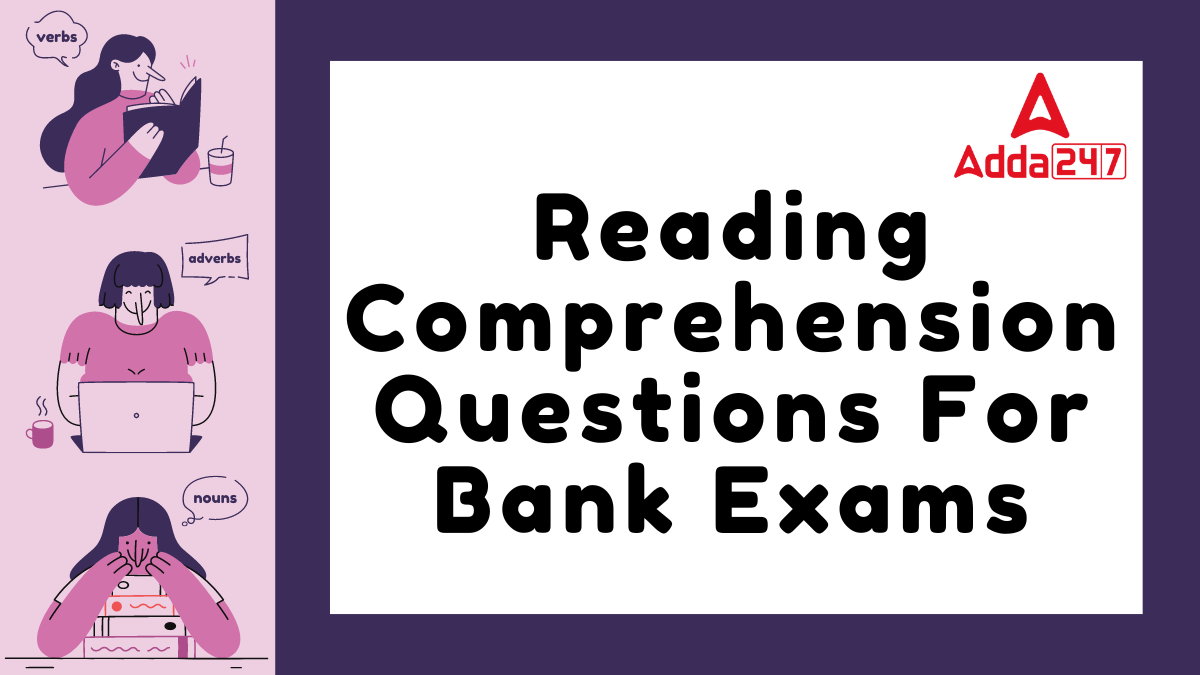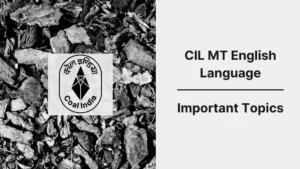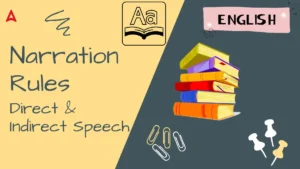Table of Contents
Reading Comprehension Questions For Bank Exams plays a vital role in the overall success of the student to ace the exam. There are around 7-10 questions based on the reading comprehension asked in the banking exam. However, the number may vary depending on the exam and the organization which is carrying out the recruitment process. It assesses your ability to understand, analyze, and interpret written information, which is crucial for various banking roles.
Reading Comprehension Questions For Bank Exams
Reading Comprehension Questions For Bank Exams require you to compare and contrast information or analyze cause-and-effect relationships. These questions test your ability to understand and interpret written information. The passages used can vary in length and complexity, covering topics like current affairs, economics, finance, and general knowledge. By practicing these types of questions and developing your reading comprehension skills, you can improve your performance in banking exams and better understand the complex information presented in the financial industry.
Reading Comprehension Question 1
Grameen is now one of the world’s biggest microfinance organizations. It began by offering small loans to underprivileged entrepreneurs in Bangladesh, helping them transition from mere survival to building a livelihood. The founders’ key realization was that, despite limited assets, these borrowers reliably repaid their loans. Since then, Grameen and microfinance have become vital tools in developing economies. Grameen’s unique approach, unlike other microfinance models, relies on group lending. Borrowers vet each other, linking their financial outcomes and removing the need for costly loan officers, which keeps expenses low. Grameen’s ultimate goal is to use business loans as a tool for individuals to escape poverty. Lately, Grameen has tackled a new challenge by launching operations in the US. Despite the lingering effects of the recession, America still has over 100,000 bank branches. Globally, microfinance hinges on borrowing cheaply and keeping defaults and overheads low. To do so, microlenders like Grameen often charge very high interest rates, ranging from 60% to 70%, which compensates for risks and secures funding from banks. However, in the US, rates much above 15% would likely be criticized as exploitative. This raises the question of whether a major player from the developing world can succeed in the largest economy. Grameen America is optimistic, aiming to turn a profit in a few years by serving 9 million US households without bank access and 21 million using services like payday loans and pawn shops. Yet, attracting the unbanked won’t be easy, as US microfinance has struggled to be profitable. Without profit, microlending turns into charity. In its first US attempt in the late 1980s, Grameen stumbled—banks following Grameen’s guidance suffered 30% loan losses. But Grameen America believes the new effort will succeed because it’s directly providing the loans. Most of its US borrowers already have jobs (such as factory work) or small businesses (like selling toys or cleaning houses). Grameen loans mostly offer stable funding but don’t necessarily create new businesses. Beyond money, group members serve as vital sources of support for each other.
Answer the Following Questions Based on the above Comprehension:
Q1. What has adversely affected the success of microfinance institutions in the US?
(a) The focus of these institutions is on making a profit at any cost instead of being charitable to the needy
(b) American banks engaged in microlending were the most severely hit during the recession
(c) A widespread perception is better suited to developing countries
(d) Their failure to attract those outside the formal banking system as customers
(e) American‘s are too proud to accept aid from Third World Countries
Ans. (d)
Q2. Why was Grameen made a second attempt to launch itself in the US?
(a) The willingness of US banks to provide the necessary staff and funds to facilitate the spread of microfinance
(b) The rates of interest on loans in the US are exorbitant, making it easier to recover capital.
(c) The realization that a large percentage of the American population not reached by mainstream banks can be tapped
(d) Recognition of the fact that disbursing credit in developing countries during the recession is too risky
(e) None of these
Ans. (c)
Q3. Which of the following can be inferred from the passage?
(a) Microfinance has been effective only in Asian nations
(b) Microfinance makes individual borrowers dependent rather than independent
(c) America has the largest number of banks in the world
(d) There is scope for microfinance institutions to be profitable in developed countries
(e) There are no informal sources of credit in developed countries
Ans. (c)
Q4. According to the author, what has enhanced the likelihood of success for Grameen America at present?
(a) Its success in Bangladesh and other developing countries
(b) Absence of other microfinance institutions for competition
(c) The fact that America is currently in the midst of a recession
(d) It provides loans at nominal rates of interest ie below 15 percent
(e) None of these
Ans. (e)
Q5. Which of the following can be said about Grameen?
(A) Its success in developing countries will ensure its success in developed countries
(B) It guarantees that the unfortunate in developing countries enjoy a survival standard of living
(C) It has demonstrated that the poor are far more likely to repay loans than the affluent
(a) None
(b) Only (A)
(c) Only (A) and (C)
(d) Only (B)
(e) Only (C)
Ans. (a)
Q6. What is the central theme of the passage?
(a) The conventional that Grameen is doomed to fail in developed countries
(b) A comprehensive evaluation of the current status of the American economy
(c) A brief discussion about the forecasts of Grameen and microfinance in the US.
(d) The role of banks in facilitating micro-lending efforts in developed nations
(e) Microfinance efforts are useful in developing countries but are futile in developed ones.
Ans. (c)
Q7. Why was Grameen America‘s initial US initiative of a flop?
(A) Shortage of correct training to Grameen American staffs.
(B) Grameen‘s refusal to adapt their system to meet the needs of the American poor.
(C) It ended up giving loans at half their customary rates of interest
(a) None
(b) only (A)
(c) Only (A) and (C)
(d) Only (B)
(e) Only (C)
Ans. (b)
Q8. Which of the following is a benefit of the Grameen system of microfinance?
(a) If a single member is unable to repay a loan, other group members will repay
(b) Dispensing with the expense of technology networks to monitor advances
(c) It utilizes the vast bank network already existing in a country
(d) Group members can sanction loans and verify if borrowers have sufficient collateral
(e) Backing that borrowers receive from other group members
Ans. (e)
Q9. Which of the following is most similar in meaning to the word ―ELUDED‖ as used in the passage?
(a) Avoided
(b) Duped
(c) Abandoned
(d) intangible
(e) Betrayed
Ans. (a)
Q10. Which of the following is most opposite in meaning to the word ―COLOSSAL as used in the passage?
(a) short
(b) Lavish
(c) Minority
(d) Frugal
(e) Insignificant
Ans. (d)
Reading Comprehension Question 2
This past decade has witnessed a surge in wildlife tourism that has doubled and tripled the tourist load in several of the more accessible national parks and reserves. But serious infrastructural shortcomings have brought us precariously close to a breakdown of the ecosystem‘s capacity to absorb this load. The result is an unsatisfactory tourist experience (and an opportunity to impart conservation values lost), overworked, pressurized and confused wildlife staff, and occasional man-animal confrontation crises such as man-killing by tigers. Not to speak of the ecosystem that is being battered by humans. A road area, which accommodated four vehicles a day, ten years ago, is now being used by 12 a day. The road area wildlife population of that area has in any case gone up. A collision of interests is inevitable. An important function of wildlife refuges is to encourage tourism. recognizing that it forms an ideal ―hands-on‖ method of orienting, educating, and winning the hearts and minds of the general public over to conservation values and concepts. This can only be achieved by communication with tourists before and during their visits to a wildlife refuge. The ―interpretation‖ as it is generally referred to, is properly done by having an interpretation centre, consisting of photographic, written and audio-visual exhibits supplemented by free or priced literature and a person on hand to answer the queries of visitors. Tourists should perforce be routed through this facility by the simple expedient they have some time to see it while their entry permits are being prepared. The general message should be the history of the wildlife refuge as a conservation microcosm, interesting facts of some of the species it supports, and an explanation of the mechanics of an ecosystem and its relevance to man, plus codes of conduct specific to the area and to wildlife and jungles in general. This should be backed up by a cadre of trained naturalist guides, preferably from the local population, who should accompany the tourists in the refuge. In some of our wildlife refuges, very poor facilities for this sort of thing exist. In most, none exist at all. The result is tourist traffic, which is generally quite ignorant of wildlife, ecology, and conservation values, who leave the refuge no wiser than when they came in. leaving behind for good measure the detritus of their presence: plastic bags, cigarette packets, bottle, paper, a lot of which is nonbiodegradable and toxic. Added to this is the fact that wildlife guards and rangers are often diverted from their normal work monitoring and managing wildlife and the ecosystem –and made to guide tourists and generally be at the back and call of people, irrelevant to the priorities of the wildlife refuge.
Answer the Following Questions Based on the above Comprehension:
Q1. Which of the following is not true in the context of the passage?
(a) The forest staff are diverted from their normal work
(b) The priorities of the wildlife are sometime ignored by the forest staff.
(c) The tourists are generally equipped with the necessary knowledge of wildlife
(d) The tourists leave behind lots of toxic disposals
Ans. (c)
Q2. According to the passage, the main purpose of bringing tourists in the forest areas is
(a) to involve the general public in maintaining the ecosystem
(b) to educate the general public about wildlife and ecosystem
(c) to reduce the wildlife population
(d) to make them understand the codes of conduct of the jungles
Ans. (a)
Q3. Which of the following best explain this according to the passage?
(a) Unwillingness to build more road area vis-à-vis load of vehicular traffic
(b) Development of tourism vis-à-vis the conservation of the ecosystem
(c) Better tourist capability vis-à-vis lack of funds
(d) Positioning people to ecosystem and also destruction of the ecosystem.
Ans. (d)
Q4. What, according to the author, should be the step to improve the situation?
(a) Tourists should be briefed about the nature of wildlife and jungle
(b) Tourists should be briefed about the inter-relation between man and animals
(c) Tourists should be briefed about the information before they enter the jungle
(d) All of these.
Ans. (b)
Q5. What according to the author, will win the hearts and minds of the general public?
(a) Providing them with better facilities.
(b) Providing them with trained guides
(c) Providing them with good food articles
(d) Providing them with better communication about the wildlife refuge
Ans. (d)
Q6. What, according to the passage, should the forest staff be engaged in?
(a) They should look after the well-being of wildlife
(b) They should take care of the habitat of wildlife
(c) They should provide tourists with necessary information about wildlife.
(d) They should take the help of the local people to take care of the tourists.
Ans. (b)
Q7. The main concern expressed by the author in the above passage is to
(a) improve facilities for tourists
(b) build more road areas
(c) restrict wildlife population
(d) balance the ecosystem by careful planning.
Ans. (d)
Q8. Which of the following words is most nearly the same in meaning as the words ―on hand as used in the passage?
(a) practical
(b) available
(c) useful
(d) knowledgeable
Ans. (b)
Q9. Man-animal confrontation, according to the passage leads to
(a) Killing of tigers by man
(b) Killing of animals by other animals
(c) Confusion of wildlife staff
(d) Destruction of mutual bond
Ans. (d)
Q10. What, according to the author, is the main reason for the near collapse of the capacity of the ecosystem of wildlife refugees?
(a) Increase in tourist inflow
(b) Felling of trees indiscriminately
(c) Absence of adequate wildlife habitat
(d) Absence of adequate infrastructural
Ans. (d)




 Important Topics for CIL MT English Lang...
Important Topics for CIL MT English Lang...
 Idioms and Phrases Questions for SBI Cle...
Idioms and Phrases Questions for SBI Cle...
 Narration Rules for Direct & Indirec...
Narration Rules for Direct & Indirec...





